
Enter our competition to win
one of four copies of Empire At War!
When it comes to waiting for PC games I'm usually a patient person - having been taunted by delayed releases for Halflife 2, TIE Fighter and Halo 2 - but the wait for Empire At War was particularly arduous. Whenever one of their newsletters dropped into my inbox I'd make a bee-line to the official EAW website to find out what new elements had been added. And then when the single-player demo came out I was too excited for words.

Set just before the events of A New Hope, Empire At War sees the Galactic Empire bringing peace to the galaxy. Pitted against the military might of Palpatine's hordes are pirates, Rebels and partisans who are set on rejecting the order being offered to them. As either the Empire or the Rebel Alliance the player can control fleets and armies from the Core all the way to the Outer Rim and shape the destiny of the galaxy.
The single-player game comes in three forms. The skirmish mode which is closer akin to the Commander & Conquer games whereby the player goes head-to-head against an adversary. Tactical battle is the key element here, and the player must monitor his resources whilst building up an army whilst engaged in battle (unlike the campaign game - more on that later). Game format number two is galactic conquest. In this scenario the player must take over the entire galaxy (albeit a cut-down version with fewer planets). Without a Star Wars-based story to drive your crusade you can do it the style of your choosing, much in the same way as Petroglyph's earlier Civilisation games. The third variety of EAW is the campaign, and since this is the bulk of the game it is this article's chief focus. In the campaign mode the action takes place on two levels:
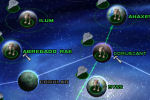 The
galactic map is the strategy layer and shows the locations and allegiances of
the thirty plus planets that are involved in the game, as well as your troop
deployment and resource locations. From the galactic map you can click on a
planet and zoom in to control construction, defense, troop and hero details as
well as certain economic aspects. Each planet is different in terms of landforms,
indigenous species and culture which all adds up to unique bonuses that allow
you to build certain units more cheaply or increase production speeds - for
example Kuat is the place to head to to build up your Imperial fleets, while
holding Bothawui reveals tactical information of nearby systems. All planets
can support basic military infrastructure like barracks, weapons factories and
training academies which build the cannon fodder you need to take over the galaxy,
and you can even supplement your bases with defensive structures to protect
them from external attack.
The
galactic map is the strategy layer and shows the locations and allegiances of
the thirty plus planets that are involved in the game, as well as your troop
deployment and resource locations. From the galactic map you can click on a
planet and zoom in to control construction, defense, troop and hero details as
well as certain economic aspects. Each planet is different in terms of landforms,
indigenous species and culture which all adds up to unique bonuses that allow
you to build certain units more cheaply or increase production speeds - for
example Kuat is the place to head to to build up your Imperial fleets, while
holding Bothawui reveals tactical information of nearby systems. All planets
can support basic military infrastructure like barracks, weapons factories and
training academies which build the cannon fodder you need to take over the galaxy,
and you can even supplement your bases with defensive structures to protect
them from external attack.
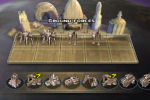 However one drawback of the planetary view is that
you can't see your base like you can in the Command & Conquer titles, which
means that when it comes to a tactical battle (should you be attacked) you have
no control over how the base is set up. Building up your space fleets means
adding a space station, which isn't cheap but is ultimately a lot more fun than
increasing the number of ground pounders at your disposal. Increasing the size
and level of your space stations not only allows you to improve your fleet but
also install orbital defensive measures that can put more than a dent into a
capital ship.
However one drawback of the planetary view is that
you can't see your base like you can in the Command & Conquer titles, which
means that when it comes to a tactical battle (should you be attacked) you have
no control over how the base is set up. Building up your space fleets means
adding a space station, which isn't cheap but is ultimately a lot more fun than
increasing the number of ground pounders at your disposal. Increasing the size
and level of your space stations not only allows you to improve your fleet but
also install orbital defensive measures that can put more than a dent into a
capital ship.
It is all too easy to get drawn into micro-managing planetary output, but you must remember that the game is in real time and all the effort put into building up a fleet to invade your next planet might give the Rebels a chance to jump a march on you. It is also dangerous to spend all of your daily income, generated by planetary taxation controlled by the game's AI, industrial facilities you install or smugglers you send out to steal, on military might because failing to invest in technological development means you will fall by the wayside. Pitting your laser-rifle armed ground troops against a T4-B Heavy Tank is a recipe for disaster. Finding that balance point between destruction and construction is what you should aim for straight away.
Moving your military resources from planet to planet via the hyperspace lanes will eventually result in contact with an enemy force - be it the Rebel Alliance or pirates - which occurs on the tactical level. This view is of the battlefield on which the conflict will take place, be it in orbit or on the ground. It is conflict, not diplomacy, that is the true aim of EAW and so the heart of the game is warfare but should you be more interested in the strategy of taking over a galaxy then the auto-resolve option is one you will be taking more often than not. This allows you to skip over any battle and lets the AI determine the outcome of the clash, letting you see the bigger picture. So if you consider yourself more of a Palpatine than a Veers remember to keep your eye out for this red button whenever an attack is about to take place.
If you have spent anytime in the RTS genre you will know the basic precept of any battle is "might is right". The one flaw
that every strategy game has is that if you've got enough firepower you can overcome your foe. This fact of war is as true in
EAW as it is any other game of the same ilk. Luckily Petroglyph have made some tweaks to their land battle engine that means
the player can't just keep producing infantry and mech units until the enemy is ground down (aka the tank rush). 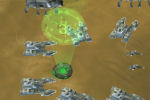 With
resource gathering out of the picture the number of units under a player's control is limited to the number of reinforcement
points he can capture. Guarding these locations is vital because they can be captured by opposing forces and cut off the
player from resupply (which is only possible when enough units have been lost). Further complications arise from weather
conditions which can affect the speed, range and accuracy of different units as well as line of sight and height differences
in front line combat situations. And woe betide the player who has to defend against the combatant with space superiority
because they can call down tactical bombing runs.
With
resource gathering out of the picture the number of units under a player's control is limited to the number of reinforcement
points he can capture. Guarding these locations is vital because they can be captured by opposing forces and cut off the
player from resupply (which is only possible when enough units have been lost). Further complications arise from weather
conditions which can affect the speed, range and accuracy of different units as well as line of sight and height differences
in front line combat situations. And woe betide the player who has to defend against the combatant with space superiority
because they can call down tactical bombing runs.
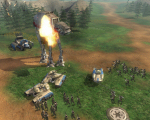 If
there was one aspect of EAW that I could improve it would be the ground battle
engine because it is the only disappointing feature in the game. Many other
reviewers have commented on the poor AI that Petroglyph lumbered the player
with but for me the biggest drawback to planet-side action is the terrain.
From Alexander the Great to Monty, any battlefield commander worth their salt
will always pick the ground on which conflict occurs in order to use the lay
of the land. Unfortunately in EAW land battles aren't much more than terrain
driven, search-and-destroy missions and so the player is not truly able to
develop any tactical skills, unlike the Total War battle simulations which are
now being utilised at officer training academies in several NATO countries.
If
there was one aspect of EAW that I could improve it would be the ground battle
engine because it is the only disappointing feature in the game. Many other
reviewers have commented on the poor AI that Petroglyph lumbered the player
with but for me the biggest drawback to planet-side action is the terrain.
From Alexander the Great to Monty, any battlefield commander worth their salt
will always pick the ground on which conflict occurs in order to use the lay
of the land. Unfortunately in EAW land battles aren't much more than terrain
driven, search-and-destroy missions and so the player is not truly able to
develop any tactical skills, unlike the Total War battle simulations which are
now being utilised at officer training academies in several NATO countries.
But for many fans the most memorable Star Wars battles weren't on land but in space. How many of us count the Battle of Endor, high above the Sanctuary Moon, as one of the finest moments in the Saga? And how about the opening scenes of Revenge of the Sith, as Anakin and Obi-Wan swooped down through the capital ships of the Separatist and Republican fleets? Where EAW really comes into its own is the space battlefield (if that's the best word to use). I really can't express what kind of a break-through Petroglyph have pulled off here - I'll try but you really need to give the game a go to get a sense of how much Star Wars they've pumped into this aspect of EAW.
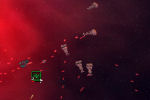 One
of the best features of duking it out in dark depths of space is that you aren't
controlled by the terrain. Don't expect to have an open field of battle however,
because limitations such as asteroids, gas clouds and debris fields can hamper
your progress. In the main navigating the overall openness of high orbit is a
lot easier to do than bump your units around a forest, city or temple ruins.
All of this takes place with the target planet spinning slowly on its access
below your fleet, giving you a sense of distance and a reminder of your objective.
Don't expect your space battles to be safe from ground fire either, because
by investing in planetary defenses you can use ion cannons to support defending
fleets. And they certainly pack a punch! And, like ground battles, you are limited
to the number of units can can deploy on the battle field but the advantage
of space is that you can position your ships pretty much anywhere in the arena,
thus establishing your pattern of attack before you even make the leap to hyperspace.
One
of the best features of duking it out in dark depths of space is that you aren't
controlled by the terrain. Don't expect to have an open field of battle however,
because limitations such as asteroids, gas clouds and debris fields can hamper
your progress. In the main navigating the overall openness of high orbit is a
lot easier to do than bump your units around a forest, city or temple ruins.
All of this takes place with the target planet spinning slowly on its access
below your fleet, giving you a sense of distance and a reminder of your objective.
Don't expect your space battles to be safe from ground fire either, because
by investing in planetary defenses you can use ion cannons to support defending
fleets. And they certainly pack a punch! And, like ground battles, you are limited
to the number of units can can deploy on the battle field but the advantage
of space is that you can position your ships pretty much anywhere in the arena,
thus establishing your pattern of attack before you even make the leap to hyperspace.
Have you ever imagined taking out the gravity well generators on an Interdictor-class Star Destroyer so that your Rebel fleet can escape, or destroying the hanger on a space station in order to prevent a fresh wave of starfighters from hampering your capital ships advance? New to the RTS genre is the ability to concentrate fire on specific points of a target. Called "hardpoints" these chinks in the armour allow you to disable vital equipment in order to progress the battle.
Like I said earlier, your development throughout the game is heavily limited by the technological state that you have achieved and so early space battles are constrained to small picket ships. It is only as you upgrade your orbital space stations that you can really enjoy the heavy guns. From the small corvettes you advance to frigates, and then on to the ships of the line - Star Destroyers and Mon Calamari cruisers. Eventually you will reach the pinnacle of military technology and the final results of Tarkin's pet project will be in your hands.
An intriguing aspect of EAW is hero units - core characters that the player can use within the game - such as Darth Vader, The Emperor, C-3PO & R2-D2, Han Solo, Boba Fett, Obi-Wan Kenobi, R2-D2 and Kyle Katarn (from Dark Forces). Each have their own abilities, special skills and vehicles that can help turn the tide of war. For instance sending Darth Vader out with his wingmen is a sure fire way to even the odds in a dogfight, but watching him send a platoon of Rebel soldiers flying into the air with a Force push is far more entertaining! But don't become too complacent because hero units are not immortal. While they can take a beating you still need to make sure that they have a chance to recuperate after a skirmish because losing one of your heroes can slow down your advance.
Graphically EAW is stupendous. Both the space battles and planetary conflicts are beautifully rendered, and the highly detailed and stunningly animated units give an aspect of scale that has never before been achieved in any Star Wars computer game. The animation is more than entertainment, as watching Acclamator-class Star Destroyers making cumbersome turns and AT-ATs plodding their way across the battlefield adds to the atmosphere of the clash. The cinematic view gives a unique view of the battlefield and lets the player experience combat as if they were watching a movie. If the initial landing scenes in Saving Private Ryan were created using 3D polygons you would be close to the experience. The attention to audio detail isn't disappointing either because Petroglyph have not only used authentic samples from LucasArts' audio library, but they have also brought in some talented voice artists to handle the character roles. (I wonder if they used Hasbro's Darth Vader Voice Changer?)
According to LucasArts the recommended resources to play EAW are an Intel PIII or AMD Athlon 1.0 GHz, a minimum of 256Mb RAM, a 32Mb 3D graphics card (with Hardware Transform and Lighting capability) and a DirectX 9.0c compatible sound card. With specs like these EAW isn't going to force you to upgrade your hardware. I played the game at a resolution of 1024 by 768 on my PC (Athlon 1.4GHz, 512Mb RAM, 256Mb GeForce FX 5200 and Creative Labs Extigy audio with Dolby 5.1) and it ran almost problem free.

The final word: EAW delivers the Star Wars strategy experience that we've all been waiting for. With the upcoming Clone Wars television series this PC gamer is hoping for an expansion set between Attack of the Clones and Revenge of the Sith which would allow players to pick between the Republic and the Separatists. Just imagine having Mace Windu, Asajj Ventress, Ki-Adi-Mundi or Durge as your hero units!
If you are planning or getting the game or already have it and want to talk to other players then join our Empire At Wars thread in the forums or for a great online player's guide to EAW head over to gamespot.com.

